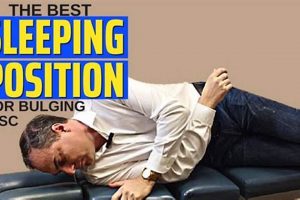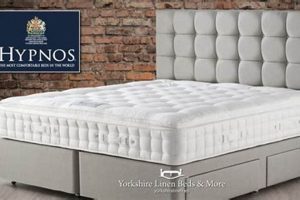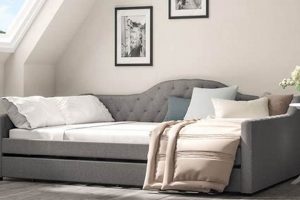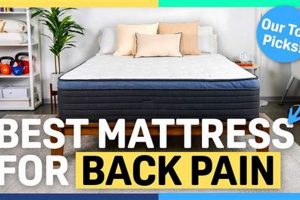Selection of a suitable sleeping surface for elevated beds is a critical consideration. These beds, often found in shared living spaces or children’s rooms, present unique challenges regarding safety, comfort, and space constraints. The specific type of mattress chosen impacts both the user’s sleep quality and the overall functionality of the bed structure.
Prioritizing the correct mattress for these structures is essential for preventing injuries from falls, particularly in the upper bunk. A well-chosen mattress also contributes to proper spinal alignment and restful sleep, improving overall well-being. Historically, these beds have been utilized in environments requiring efficient use of space, making appropriate mattress selection even more crucial.
Factors to consider when selecting a compatible mattress include height restrictions, weight capacity, mattress type, and material composition. A detailed examination of these elements will enable informed decision-making and ensure a safe and comfortable sleeping environment.
Selection Guidance for Elevated Bed Mattresses
The following guidelines address key considerations for choosing an appropriate mattress designed for use in bunk bed configurations. Adherence to these tips promotes safety, comfort, and optimal use of space.
Tip 1: Height Restriction Adherence: Mattresses must comply with the height limitations specified by the bunk bed manufacturer. Exceeding the maximum height significantly increases the risk of falls from the upper bunk due to compromised safety rail effectiveness. Always consult the bunk bed’s documentation for precise measurements.
Tip 2: Weight Capacity Verification: The chosen mattress should be suitable for the weight capacity of the bunk bed frame. Overloading the bed frame can lead to structural failure and potential injury. Ensure that the mattress, combined with the occupant’s weight, remains within the specified limits.
Tip 3: Mattress Type Considerations: Foam mattresses, particularly memory foam or latex, are often preferred due to their lighter weight and conformability. Innerspring mattresses, while potentially offering greater support, may be heavier and less adaptable to the confined space. Evaluate the pros and cons of each type relative to the specific bunk bed design.
Tip 4: Material Safety Assessment: Prioritize mattresses manufactured with hypoallergenic and non-toxic materials. Bunk beds, especially those used by children, require mattresses that minimize the risk of allergic reactions or exposure to harmful chemicals. Certifications such as OEKO-TEX Standard 100 can indicate compliance with safety standards.
Tip 5: Edge Support Evaluation: Adequate edge support is crucial for preventing roll-off, particularly on the upper bunk. Mattresses with reinforced edges provide a more stable sleeping surface and enhance overall safety.
Tip 6: Firmness Level Selection: The ideal firmness level is subjective but should consider the age and sleeping preferences of the user. A medium-firm mattress generally provides a good balance of support and comfort for a wide range of individuals.
Tip 7: Ventilation Properties: Adequate airflow within the mattress is essential for preventing moisture buildup and promoting a comfortable sleeping temperature. Mattresses with breathable materials, such as open-cell foam or coil construction, are recommended.
Adhering to these guidelines ensures a more secure and comfortable experience for users of elevated beds. By carefully evaluating height, weight, material, and support characteristics, individuals can make informed decisions that prioritize safety and promote restful sleep.
The next section will address specific mattress options suitable for different bunk bed configurations and user needs.
1. Height Restriction
Height restriction is a primary safety consideration when selecting a mattress for a bunk bed. The height of the mattress directly impacts the effectiveness of the bunk bed’s safety rails. If the mattress is too thick, it reduces the height of the rails, diminishing their ability to prevent falls, especially from the upper bunk. A mattress that exceeds the recommended height can create a dangerous scenario where a sleeping occupant could inadvertently roll over the rail during sleep.
Manufacturers of bunk beds typically specify a maximum mattress height to ensure the safety rails provide adequate protection. For instance, a common recommendation might be no more than 8 inches in mattress thickness. Exceeding this limit negates the intended safety features of the bed design. Consider a scenario where a 12-inch mattress is placed on a bunk bed designed for an 8-inch mattress; the exposed rail height is substantially reduced, rendering it less effective. This underscores the importance of adhering to the manufacturer’s guidelines.
Compliance with height restrictions is not merely a suggestion but a critical safety measure. Overlooking this aspect can have severe consequences. By prioritizing mattresses that conform to the specified height limitations, users can significantly reduce the risk of fall-related injuries. This understanding is integral to selecting an appropriate mattress for a bunk bed and promoting a safe sleeping environment.
2. Weight Capacity
Weight capacity represents a critical safety parameter in the context of bunk bed mattress selection. It dictates the maximum load the bed frame and its components, including the mattress support structure, can safely bear. Exceeding the stated weight limit introduces significant risk of structural failure, potentially resulting in injury to the occupant. The mattress, being a substantial contributor to the overall load, plays a key role in determining whether the bunk bed remains within its safe operating parameters. Choosing a mattress of inappropriate weight for the bunk bed frame introduces a direct cause-and-effect relationship, where increased mattress weight leads to elevated stress on the frame. For instance, a bunk bed designed for a maximum combined weight of 250 lbs might be compromised if a 100 lb mattress is paired with an occupant weighing 200 lbs, exceeding the safe limit by 50 lbs.
The interaction between mattress weight, occupant weight, and bunk bed weight capacity is paramount to long-term durability and safety. Ignoring this factor can lead to premature wear and tear on the bed frame, manifested as bent support beams, weakened joints, or even complete collapse. Regularly inspecting the bunk bed for signs of stress, such as creaking noises or visible bending, can help identify potential weight capacity issues before they escalate into a hazardous situation. Parents often face the practical challenge of assessing whether a particular mattress and child combination falls within the specified limits, requiring careful attention to product specifications and weight
data. Some mattress types, like innerspring models, tend to be heavier than foam alternatives, necessitating more cautious evaluation of their suitability.
In summation, adhering to the weight capacity guidelines of a bunk bed is a non-negotiable aspect of ensuring user safety. The selection of a mattress that aligns with these limits, both in terms of its own weight and its intended occupant’s weight, directly mitigates the risk of structural failure and potential injury. While various factors contribute to the selection process, including comfort and material composition, weight capacity remains a fundamental criterion that cannot be overlooked. The challenges associated with accurately assessing weight distribution underscore the importance of informed decision-making when choosing a mattress for a bunk bed environment.
3. Material Safety
The selection of a compatible mattress necessitates careful scrutiny of its constituent materials, especially in the context of bunk beds. Occupants, frequently children, are in close proximity to the mattress for extended durations, increasing potential exposure to volatile organic compounds (VOCs) and other potentially harmful substances. Therefore, material safety is not merely a desirable attribute but a critical component of what constitutes a “best mattress for bunk bed.” The presence of flame retardants, phthalates, or formaldehyde, often used in conventional mattresses, poses a risk of respiratory irritation, allergic reactions, or, in more severe cases, long-term health complications. The selection process should consider cause-and-effect: purchasing a mattress with questionable materials can directly result in negative health outcomes. Certifications from organizations such as OEKO-TEX, CertiPUR-US, or Greenguard Gold offer assurance that the mattress has undergone testing and meets specific standards for chemical emissions and material safety.
Practical application of this understanding involves prioritizing mattresses constructed from natural or low-emission materials. Options include mattresses made with organic cotton, natural latex, or plant-based foams. For example, a bunk bed mattress made with certified organic wool acts as a natural flame retardant, eliminating the need for potentially harmful chemical additives. Another practical consideration is the implementation of mattress protectors designed to create a barrier between the occupant and the mattress materials, further reducing the potential for exposure. These protectors should also be made from breathable, non-toxic materials. Furthermore, consumers can request detailed information from manufacturers regarding the composition of their mattresses, fostering transparency and informed decision-making. The challenge is to navigate marketing claims and assess the validity of certifications, ensuring they align with reputable and recognized safety standards.
In summary, material safety is an indispensable attribute of any mattress intended for use in a bunk bed. The consequences of neglecting this aspect range from mild discomfort to more serious health concerns. By prioritizing certified materials, opting for natural alternatives, and utilizing protective barriers, the risk of exposure to harmful substances can be significantly reduced. The selection of a “best mattress for bunk bed” must therefore encompass a thorough assessment of material composition, ensuring that it meets or exceeds established safety benchmarks. This holistic approach is crucial for promoting a healthy and safe sleeping environment, especially for vulnerable populations like children.
4. Edge Support
Edge support is a critical feature when evaluating a mattress’s suitability for a bunk bed. Given the elevated sleeping surface and potential for restricted movement, the stability and firmness of the mattress edge significantly impact safety and overall sleep quality.
- Fall Prevention
Robust edge support minimizes the risk of rolling off the mattress, particularly on the upper bunk. Weak or non-existent edge support can create a ‘roll-off’ sensation, especially near the edges, increasing the likelihood of accidental falls. This is particularly vital for children or restless sleepers.
- Usable Surface Area
Strong edge support maximizes the usable sleep surface. Without it, a significant portion of the mattress perimeter becomes unstable and unusable, effectively reducing the sleeping area. This is especially relevant in bunk beds where space is already limited.
- Mattress Longevity
Adequate edge support contributes to the mattress’s longevity. Consistent pressure on unsupported edges can lead to premature sagging and degradation, shortening the mattress’s lifespan. A mattress with reinforced edges maintains its shape and structural integrity for a longer period.
- Ease of Movement
Solid edge support aids in ease of movement on and off the bunk bed. It provides a stable platform for sitting on the edge of the bed, making it easier and safer to get in and out, particularly in the confined space of a bunk bed.
In conclusion, edge support is not merely a comfort feature but a fundamental safety element when selecting a mattress for a bunk bed. The presence of robust edge support directly contributes to fall prevention, maximizing usable sleep area, extending mattress lifespan, and facilitating safe movement, thus playing a significant role in determining what constitutes the “best mattress for bunk bed”.
5. Firmness Level
Firmness level significantly impacts the suitability of a mattress for a bunk bed. It directly affects spinal alignment, pressure distribution, and overall comfort, particularly relevant in the confined space of a bunk bed. A mattress that is too soft may lead to excessive sinking, potentially causing back pain or discomfort, especially for heavier individuals. Conversely, a mattress that is too firm may create pressure points, leading to restlessness and inadequate sleep quality. Selecting an appropriate firmness level is, therefore, a critical factor in determining if a mattress can be considered among the “best mattress for bunk bed” options.
The ideal firmness level is often subjective and depends on factors such as sleeping position, body weight, and individual preferences. For instance, a side sleeper generally benefits from a softer mattress that allows the shoulders and hips to sink in, maintaining spinal alignment. In contrast, a back or stomach sleeper typically requires a firmer mattress to prevent the spine from arching excessively. Given the potential for a bunk bed to be used by multiple individuals with varying needs, a medium-firm mattress is often a practical compromise, offering a balance of support and comfort for a wide range of body types and sleeping positions. Furthermore, considering the likelihood of children using bunk beds, orthopedic specialists generally recommend a slightly firmer mattress to support growing spines and promote proper posture.
In conclusion, the firmness level is an indispensable consideration when selecting a mattress for a bunk bed. Choosing the correct firmness level is not merely a matter of comfort but directly influences spinal
health and sleep quality. Factors such as sleeping position, body weight, and age should inform this decision, often leading to a preference for a medium-firm mattress as a versatile option. The “best mattress for bunk bed” will invariably be one that offers appropriate support and comfort tailored to the specific needs of its users, highlighting the practical significance of understanding and carefully considering firmness level. Challenges may arise in accommodating diverse preferences within a shared bunk bed, but prioritizing spinal alignment and support remains paramount.
6. Mattress Type
Mattress type significantly influences the suitability of a mattress for use in a bunk bed. The specific construction and materials of a mattress directly impact its weight, thickness, support, and overall comfort all critical factors in determining whether it qualifies as a candidate for “best mattress for bunk bed.” The connection between mattress type and bunk bed compatibility is causal: selecting an inappropriate mattress type can lead to safety hazards, discomfort, and a reduction in the lifespan of both the mattress and the bed frame. For instance, a traditional innerspring mattress, known for its weight and thickness, might exceed the weight capacity or height restrictions of certain bunk bed models, rendering it unsafe. Therefore, understanding the characteristics of various mattress types is essential for informed decision-making. This directly impacts the safety and satisfaction of the users.
Practical application of this understanding involves carefully evaluating mattress types based on the specific limitations and requirements of the bunk bed. Foam mattresses, particularly memory foam or latex, are frequently favored due to their relatively light weight and ability to conform to the body. This can be demonstrated in comparing mattresses with innerspring, where the high amount of metal used affects the weight of each one, and it also affects the comfort given to it’s occupants. Hybrid mattresses, which combine elements of both innerspring and foam, offer a balance of support and comfort but require careful assessment to ensure they meet weight and height specifications. Air mattresses, while adjustable, often lack the necessary stability and long-term durability for regular use in a bunk bed setting. Furthermore, material composition plays a role: mattresses made with hypoallergenic or CertiPUR-US certified foams mitigate the risk of allergic reactions or off-gassing, making them a safer option, particularly for children.
In conclusion, mattress type is a fundamental consideration when choosing the “best mattress for bunk bed.” The weight and thickness of a mattress directly impact its safety and compatibility with the bunk bed frame, while the materials and construction affect comfort and long-term durability. Prioritizing foam or hybrid mattresses that meet weight and height restrictions while offering adequate support and hypoallergenic properties ensures a safer and more comfortable sleeping environment. Despite the challenges of accommodating diverse preferences and budgetary constraints, understanding the connection between mattress type and bunk bed requirements is paramount for making an informed and responsible decision.
Frequently Asked Questions
This section addresses common inquiries concerning the selection and maintenance of mattresses designed for use in bunk bed configurations. The information provided aims to clarify key considerations and promote informed decision-making.
Question 1: What is the maximum permissible mattress height for a bunk bed?
The maximum permissible mattress height is determined by the bunk bed manufacturer and is specified in the product documentation. Exceeding this height compromises the effectiveness of the safety rails and increases the risk of falls.
Question 2: How does mattress weight affect bunk bed safety?
Excessive mattress weight can overload the bunk bed frame, leading to structural instability and potential collapse. The combined weight of the mattress and occupant must not exceed the bed’s stated weight capacity.
Question 3: Are specific mattress materials recommended for bunk beds?
Mattresses constructed from hypoallergenic and non-toxic materials are recommended, especially for children. Certifications such as OEKO-TEX Standard 100 indicate adherence to safety standards regarding chemical emissions.
Question 4: Why is edge support important in a bunk bed mattress?
Adequate edge support prevents roll-off, particularly on the upper bunk, and maximizes the usable sleeping surface. It also contributes to the overall longevity and structural integrity of the mattress.
Question 5: What firmness level is generally suitable for a bunk bed mattress?
A medium-firm mattress is often a practical compromise, offering a balance of support and comfort for a wide range of individuals and sleeping positions. The ideal firmness may vary based on the user’s age and preferences.
Question 6: How can the lifespan of a bunk bed mattress be extended?
Utilizing a mattress protector, rotating the mattress regularly, and adhering to the manufacturer’s weight capacity recommendations contribute to extended mattress lifespan. Regular inspection for signs of wear and tear is also advised.
Choosing the correct mattress for a bunk bed requires balancing safety, comfort, and durability. Adhering to manufacturer’s specifications, prioritizing material safety, and considering individual needs are paramount.
The subsequent section will delve into specific mattress brands and models that are well-suited for bunk bed applications, providing a comparative analysis of their features and benefits.
Concluding Remarks on Elevated Bed Mattress Selection
This article has explored the crucial factors involved in selecting a “best mattress for bunk bed,” emphasizing height restrictions, weight capacity, material safety, edge support, firmness levels, and mattress types. Informed decisions regarding these aspects are paramount for ensuring the safety, comfort, and well-being of bunk bed occupants.
Prioritizing these considerations when choosing a mattress for elevated sleeping arrangements mitigates potential hazards and promotes restful sleep. Further research and adherence to manufacturer guidelines are encouraged to optimize the bunk bed environment.



![Top Rated Best Feather and Down Mattress Toppers - [Year] Guide Organic & Natural Mattress Buyer’s Guide: Non-Toxic Sleep Solutions Top Rated Best Feather and Down Mattress Toppers - [Year] Guide | Organic & Natural Mattress Buyer’s Guide: Non-Toxic Sleep Solutions](https://mattressworldpa.com/wp-content/uploads/2025/07/th-7652-300x200.jpg)



![Find The Best Cheap Amazon Mattress [Deals!] Organic & Natural Mattress Buyer’s Guide: Non-Toxic Sleep Solutions Find The Best Cheap Amazon Mattress [Deals!] | Organic & Natural Mattress Buyer’s Guide: Non-Toxic Sleep Solutions](https://mattressworldpa.com/wp-content/uploads/2025/07/th-7648-300x200.jpg)